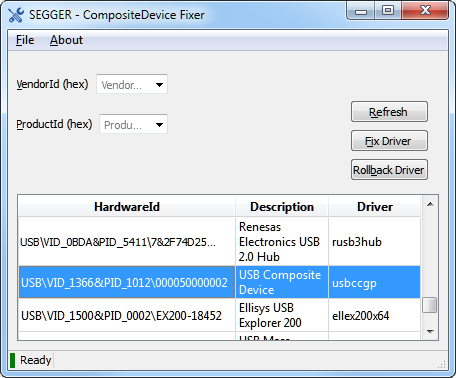There are cases under which Windows assigns the incorrect USB driver to a J-Link, resulting it being shown as generic USB BULK device. This makes it impossible to use J-Link with the J-Link software package and other software that relies on this package. Make sure that the J-Link software package, including the USB drivers are installed.
- USB Drivers Downloads & Updates | USB Driver Fix And Updates | Driver…
- [SOLVED] Unable To Load J-Link Drivers In Windows 10 - SEGGER ...
- [SOLVED] J-Link Base 9.3, USB Not Recognized After Firmware Update
- Drivers Segger Usb Devices Usb
- EmUSB-Device Add-Ons - IP over USB. Easily run any IP-based protocol over USB. Simple and driverless! Plug-and-play on any operating system. Use a web browser to look into and configure the USB device. Make IP protocols available on any USB device; Cross-platform, no drivers needed on Linux, macOS or Windows.
- SEGGER's J-Link Debug Probes are USB-powered in-circuit programmer/debuggers supporting PIC ® 32 devices through the JTAG interface. Supported by MPLAB ® X IDE (v2.15 and later), they provide cross-platform support (Windows ®, Linux, Mac OS X ®) and can be used to program or debug any PIC32 microcontroller using a JTAG or In-Circuit Serial Programming (ICSP) interface.
- If drivers were not downloaded automatically by Windows Update, use Device Manager to refresh the driver from Windows Update, or contact the device manufacturer. I’m Moli, your virtual agent. I can help with Moto phone issues.
- The J-Link is a composite device containing multiple interfaces. In order to work with it on Windows, Windows loads a composite Device driver. The information for this driver are in the usb.inf. Once the composite device driver is installed all other interfaces of the J-Link will be installed automatically. In order to fix this.
Communication Device Class - Abstract Control Model (CDC-ACM)This USB class is usually used for serial port emulation and as a modem interface.The class is also often used in combination with older software which previously used RS-232 to communicate with an external device.
- 1Accessing CDC
Accessing CDC on Linux
On Linux no drivers are needed, the device should show up as/dev/ttyACM0 or similar. 'sudo screen /dev/ttyACM0 115200'can be used to access the device.
Accessing CDC on Windows
On Windows 8.1 and below the 'usbser' driver is not automaticallyassigned to the CDC-ACM device. An .inf file for the CDC-ACM device must be installed on these older systems. The device can be accessed via COM portemulation programs e.g. PuTTY.
Accessing CDC on macOS
On macOS no drivers are needed, the device should show up as/dev/tty.usbmodem13245678 or similar. The 'screen' terminalprogram can be used to access the device.
Windows 10 comes with a re-designed driver for CDC-ACM. At the time of writing (June 2019) Windows 10 has an issue with large IN CDC transfers. Sometimes packets seems to disappear inside the Windows 10 USB stack.
The only workaround is to read in small chunks. Or to add a delay to the transfers.We have analysed this using a hardware USB analyser and a test program whichreads data from the device. The device (USB high-speed) sends out data continuously in 512 bytes packets. Each packet has a unique, consecutive ID.The test application checks that the received packet always has the ID of the previous packet + 1. After a couple dozen packet the error usually appears and a packet ends up missing.When comparing the packets which are seen 'on the wire' using the USB analyser with the packets which the Windows 10 program received it can be seen that sometimes packets are missing even though they were clearly successfully received by Windows 10. E.g. on the analyser one can see packets 30, 31, 32, 33 and on Windows 10 one can see 30, 31, 33. It would appear that the method through which data is read from the COM port (Windows API ReadFile, ReadFile overlapped or ReadFileEx) has no effect on the missing packets.
When using the same program on Windows 7 no issues can be seen.
Why J-Link?
In case you wonder why Eclipse Embedded CDT decided to provide support forSEGGER J-Link, the short answer is: because ofJ-Link EDU and of SWO.The long answer may include the following:
- wide processor support (probably you won’t find an unsupported Armprocessor in the entire galaxy, and if you do find one, in a remote quadrant,I’m pretty sure it’ll be shortly added to the list)
- it is a true multi-platform solution, providing drivers forWindows, macOS and GNU/Linux, Intel and Arm.
- it comes with a standard GDB server implementation, compatible withexisting Arm toolchains
- in addition to the classical JTAG protocol, it implements thenew SWD protocol
- when SWD is selected, it is capable to sample the SWO pin, fortrace messages and other Arm specific debugging
- it is fast, up to 15 MHz for JTAG clock and up to 7.5 MHz SWOsampling frequency for the new V9 hardware (12 MHz JTAG / 6 MHz SWO forV8, and even up to 100 MHz SWO for the high-performanceULTRA+, PRO models)
- it supports all possible target voltages, from 1.2V to 5V
- in addition to the regular debugging functionality, it is also ableto write the internal flash, and, even more, it uses a smart flashwriting algorithm, to avoid unnecessary writes if the flash blocks didnot change
- it is a mature, proven product, with a great support team
- it provides an entire range of probes,J-Link,J-Link Pro, including aspecial priced version for educational use, theJ-Link EDU (available frommany distributors, for example from Farnell)
The J-Link was present on the JTAG market for many years, but,considering the initial prices, only commercial companies could afford them.After a fierce fight against Chinese clones, sold for a fraction of theprice, in 2012 SEGGER decided to introduce alow price version, J-Link EDU,restricted to educational and non-commercial usage, making it the JTAGprobe of choice for open source Arm development.
USB Drivers Downloads & Updates | USB Driver Fix And Updates | Driver…
Overview
J-Link comes not only with a GDB server, but with a complete set ofdrivers and utilities, packed by SEGGER separately for each platform.The same distribution includes drivers for all J-Link probes, soinstallation is quite simple. The J-Link binaries are availablefrom the SEGGER site.
There are different sections, grouped by platform (Windows, macOS,Intel GNU/Linux, Arm GNU/Linux); go to the platform of your choice.
Click the Download button close to theJ-Link Software and Documentation Pack appropriate for yourdevelopment platform. For Linux there are separate 32/64-bit versions,packed with different tools (DEB, RPM, TGZ); select the package thatbetter matches your system.
Accept the terms of the software agreement and download the software.
Documentation
The J-Link GDB server is documented in theUM08001 manual,available either in the installed folder, or from theSEGGER J-Link page.
Install
The Windows download is an executable installer, named likeJLink_WindowsV684.exe.
- double click it to start the installation process
- enter the administrative password
- accept the license
- accept the destination folder (
C:Program Files (x86)SEGGERJLink) - accept the default USB driver
The result of the install is a folder, and a set of driver files installedin the system folders, all overwritten with each new install.
Please note that on Windows, SEGGER provides both graphical interfaceand command line versions (having the names suffixed with CL) formost of their tools. For the J-Link plug-in it is recommended to useonly the command line version of the J-Link GDB server(JLinkGDBServerCL.exe).
The macOS download is a macOS package installer, named likeJLink_MacOSX_V684.pkg.
- double click it to start the installation process
- accept the license
- enter the administrative password, required to write in the global
/Applicationsfolder
The result of the install is a folder like /Applications/SEGGER/JLink_V684/(a different folder for each version) where all executables and libraries arestored; please note that, as for many macOS applications, no other driverfiles are installed in the system folders, but some symbolic links to the latestinstalled version are created in the /usr/local/bin folder.
Be sure to update the path in Eclipse preferences page to point to thelatest SEGGER J-Link software.
USB
On macOS, the USB subsystem automatically identifies and allows accessto USB devices, without the need to maintain a manual list similar tothe one used by UDEV in GNU/Linux. No other drivers or systemconfigurations are required.
As already mentioned, there are multiple packages available for GNU/Linuxon the SEGGER download site, in 32/64-bitversions. Preferably download the .tgz and install it in your home folder.
For example, on Ubuntu,to install the 64-bit .tgz file, use the following commands:
Raspberry Pi OS
On a Raspberry Pi OS 64-bit, use the 64-bit .tgz file, and unpackit in ${HOME}/opt/SEGGER:
UDEV
After manually unpacking the .tgz, you need to copy the rules file:

~/opt/SEGGER path, since by default the Eclipse Embedded CDT plug-inssearch for the executables in this location. Be sure you respect the case,it is all upper-case SEGGER.Testing
To test if J-Link is able to connect to a specific board, you generallyneed to specify the interface (JTAG or SWD) and the device name. Bydefault, J-Link GDBServer will try JTAG but if only SWD is wired(which is very common on custom hardware), you would need to specifythe interface (-if SWD). The device name is needed for targets whichrequire special handling on connect (e.g. due to silicon bugs whichmake auto-detection impossible). For a list of available device names,please refer to the SEGGERSupported devices page.
Here is an example how to test aSWD connection to a STM32F407 evaluation board (-device STM32F407VG)on macOS.
[SOLVED] Unable To Load J-Link Drivers In Windows 10 - SEGGER ...
On Windows, to start the GDB server, use back-slashes in the path and theCL (command line) version:
On Ubuntu the command is simple:
In all cases, the result should be similar to the one obtained on macOS.
The J-Link plug-in
[SOLVED] J-Link Base 9.3, USB Not Recognized After Firmware Update
If you successfully installed SEGGER binaries, you can proceed to thepage documenting how to use the Eclipse Embedded CDTJ-Link debugging plug-in.
Comments on the content of this page that might be useful for other readers are welcomed here. For question and general support, please use the project forums.
Drivers Segger Usb Devices Usb
Please enable JavaScript to view the comments powered by Disqus.